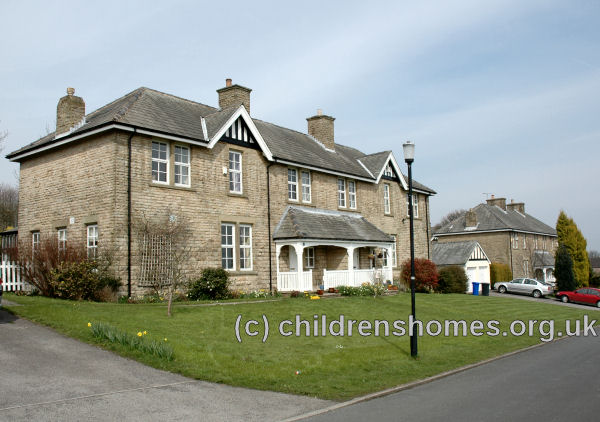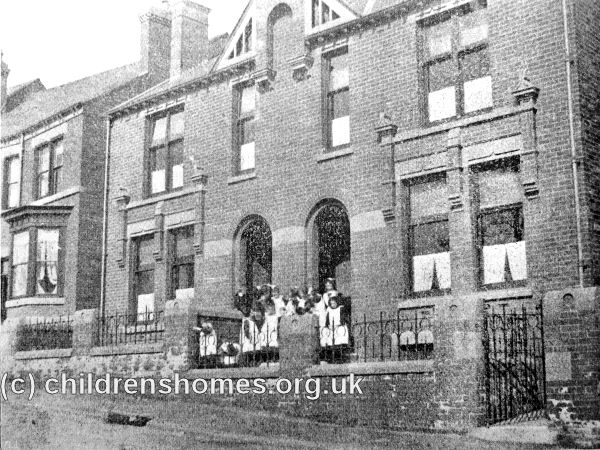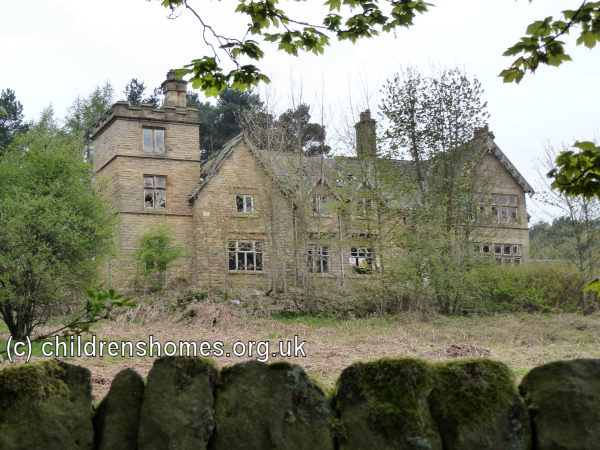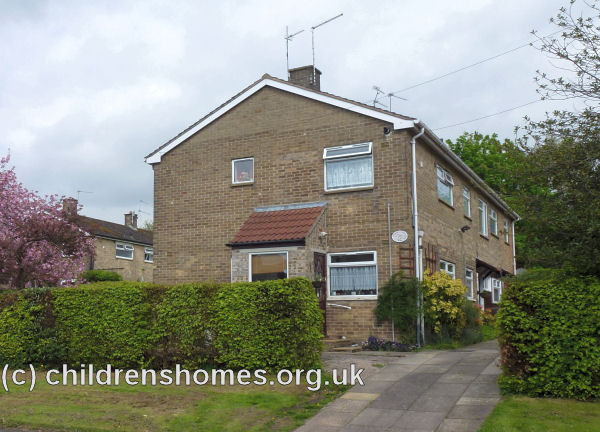Sheffield Council Homes
In 1930, following the abolition of the Sheffield and Ecclesall Bierlow Poor Law Unions, the Sheffield Corporation took over responsibility for the administration of poor relief in the city. This included the children's homes previously run by the two unions, which now came under the management of the council's new Public Assistance Committee.
The homes initially operated by the council are listed below.
| Location | Places |
|---|---|
| Fulwood Cottage Homes | 295 |
| Headquarters Homes, Smilter Lane (now Herries Road) | 95 |
| Receiving Home, Smilter Lane | 20 |
| Residential Nursery, Smilter Lane | 68 |
| 14 Abbeyfield Road | 11 |
| 16 Abbeyfield Road | 11 |
| 23 Hucklow Road Road | 11 |
| 25 Hucklow Road | 11 |
| 71 Scott Road | 10 |
| 73 Scott Road | 10 |
| 399 City Road | 11 |
| 401 City Road | 11 |
| 15 Manor Lane | 11 |
| 17 Manor Lane | 11 |
| 521 City Road | 11 |
| 523 City Road | 11 |
| 75 Duchess Road | 11 |
| 77 Duchess Road | 11 |
| 278 Edmund Road | 11 |
| 280 Edmund Road | 11 |
| 110 Heeley Bank Road | 11 |
| 112 Heeley Bank Road | 11 |
| 196 Heeley Bank Road | 11 |
| 198 Heeley Bank Road | 11 |
| Working Boys' Home, 279-281 Grimesthorpe Road | 11 |

Former Fulwood Cottage Homes, 2006. © Peter Higginbotham

"Scattered homes at 71-73 Scott Road, c.1903. © Peter Higginbotham
By the start of the Second World War, all the scattered homes had closed and children were no longer being housed at the Smilter Lane site. The Fulwood cottage homes provided the bulk of the council's children's accommodation, supplemented by Thornseat (or Thornsett) Lodge, a remotely situated house near Bradfield, at the edge of the Peak District.

Thornseat Lodge, Higher Bradfield, 2013. © Peter Higginbotham
Following the passing of the 1948 Children Act, councils were required to provide care services for all needy children in their area, especially those who lacked a normal family home. In common with other local authorities, the council established a new Children's Committee, whose responsibilities had previously been spread across separate Health, Education and Social Welfare Committees. As well as the Fulwood cottage homes (by then renamed Blackbrook Mount) and Thornseat Lodge, the new Children's Department also became responsible for the Boys' Remand Home at Shirecliffe Lane, the Girls' Remand Home at 'The Dene', 104 Upperthorpe, a residential nursery at Moss Limb Lane, Dore, and a Reception Centre at 23 Broomgrove Road.
By 1956, new homes had been established at 99 Halifax Road, Grenoside, and 94 Stradbroke Drive, Sheffield. In 1959, a further home had been opened at 35 Broomgrove Road.
The conversion of Blackbrook Mount to the Moorside Approved School for Girls in 1960 was accompanied by the opening of around a dozen new small homes around the city. These were located at:
| 33 Blackstock Road, Sheffield |
| 12 Morland Drive, Sheffield |
| 172-174 Reney Avenue, Sheffield |
| 89-91 Beaumont Road North, Sheffield |
| 52 Everingham Crescent, Sheffield |
| 2 North Hill Road, Sheffield |
| 37 Halsall Avenue, Sheffield |
| 45 Mather Road, Sheffield |
| 46 Richmond Park Drive, Sheffield |
| 5 Richmond Park Close, Sheffield |
| 414 Halifax Road, Grenoside, Sheffield |
| Nursery, 16 Hallamgate Road, Sheffield |

172-174 Reney Avenue, Sheffield, 2014. © Peter Higginbotham
In the 1960s, a number of changes took place in the other types of accommodation run by the Children's Department. By 1964, a Mother and Baby Home was opened at 19-21 Hucklow Road, Sheffield. 'The Dene', at 104 Upperthorpe, became a boys' hostel. A girls' hostel was opened at 35 Broomgrove Road, later moving to 'Barncliffe', on Redmires Road. A mixed hostel was opened at Eastcliffe Lodge, on East Bank Road. The former nursery on Moss Limb Lane became a second Reception Centre, known as Rye Croft Glen. A Children's Centre was established at Todwick Grange, Sheffield Road Aston.
Sheffield was relatively unaffected by the local government reorganisation that took place in 1974, although the council did take over the home at 230 Lane End, Chapeltown, previously run by the West Riding County Council. Its provision for children and young people continued to expand, with its accommodation stock in 1977 listed below:
| Ballifield Hall, Retford Road |
| 89-91 Beaumont Road North |
| 33 Blackstock Road |
| Oakfield House, 6 Broomhall Road |
| Osborn House, Burngreave Road |
| Lydgate, Cross Lane |
| 52 Everingham Crescent |
| 414 Halifax Road, Grenoside |
| 16 Hallamgate Road |
| 230 Lane End, Chapeltown |
| 37 Halsall Avenue |
| 46 Richmond Park Drive |
| Ryecroft Glen, Limb Lane |
| 45 Mather Road |
| 12 Morland Drive |
| 2 North Hill Road |
| 94 Stradbroke Drive |
| 172-174 Reney Avenue |
| Thornseat Lodge, Bradfield |
| Nursery and Home, Chancet Wood Drive |
| Mother and Baby Home, 19 Hucklow Road |
| Richmond Reception Centre, 5 Richmond Park Close |
| Children's Centre, Todwick Grange, Sheffield Road, Aston |
| Boys' Remand Home, Shirecliffe House, Shirecliffe Lane |
| Boys' Hostel, The Dene, 104 Upperthorpe |
| Girls' Hostel, Barncliffe, Redmires Road |
| Mixed Hostel, Eastcliffe, East Bank Road |
| Moorside School, Blackbrook Road |
| Home for Mentally Handicapped Children, 336 Ringinglow Road |
By 1983, a number of closures had taken place including 33 Blackstock Road, 6 Broomhall Road, 5 Richmond Park Close, 46 Richmond Park Drive and Thornseat Lodge. Provision for mentally handicapped children had expanded, however, with additional homes: Rushey Meadow on Bannererdale Road and Stratford House on Guildford View.
Children's establishments run at some time in their history by Sheffield Council.
- Lane End House, 230 Lane End, Chapeltown†
- Rushey Meadow Home for Mentally Handicapped Children, 1 Bannerdale Road, Sheffield
- Dene Remand Home for Girls, 104 Upperthorpe, Sheffield
- Dene Hostel for Boys, 104 Upperthorpe, Sheffield
- Sheffield Union Scattered Home, 110-112 Heeley Bank Road, Sheffield*
- 12 Morland Drive, Sheffield
- Osborn House, 138 Burngreave Road, Sheffield
- Sheffield Union/Council Scattered Home, 14-16 Abbeyfield Road, Sheffield*
- Sheffield Union Scattered Home, 15-17 Manor Lane, Sheffield*
- Residential Nursery, 16 Hallamgate Road, Sheffield
- 172-174 Reney Avenue, Sheffield
- Sheffield Corporation Mother and Baby Home, 19/21 Hucklow Road, Sheffield
- Sheffield Union Scattered Home, 196-198 Heeley Bank Road, Sheffield*
- 2 North Hill Road, Sheffield
- Grove Reception Centre, 23 Broomgrove Road, Sheffield
- 23-25 Hucklow Road, Sheffield*
- Working Lads Home, 279-281 Grimesthorpe Road, Sheffield
- Strafford House Home for Mentally Handicapped Children, 300 Guildford View, Sheffield
- 33 Blackstock Road, Sheffield
- Ringinglow Home for Mentally Handicapped Children, 336 Ringinglow Road, Sheffield
- Hostel for Girls, 35 Broomgrove Road, Sheffield
- 37 Halsall Avenue, Sheffield
- 414 Halifax Road, Grenoside, Sheffield
- 45 Mather Road, Sheffield
- 46 Richmond Park Drive, Sheffield
- Richmond Reception Centre, 5 Richmond Park Close, Sheffield
- 52 Everingham Crescent, Sheffield
- Oakfield House, 6 Broomhall Road, Sheffield
- Sheffield Union/Council Scattered Home, 71-73 Scott Road, Sheffield*
- Sheffield Union/Council Scattered Home, 75-77 Duchess Road, Sheffield*
- 89-91 Beaumont Road, Sheffield
- 94 Stradbroke Drive, Sheffield
- 99 Halifax Road, Grenoside, Sheffield
- Ecclesall Bierlow Union / Sheffield Council Cottage Homes, Blackbrook Mount, Blackbrook Road, Fulwood, Sheffield*
- Moorside School, Blackbrook Road, Fulwood, Sheffield
- Nursery and Home, Chancet Wood Drive, Sheffield
- Lydgate, Cross Lane, Sheffield
- Sheffield Union/Council Receiving Home, Daisy and Fern Cottages, Smilter Lane (now Herries Road), Sheffield*
- Eastcliffe Lodge Mixed Hostel, East Bank Road, Sheffield
- Residential Nursery, Herries Road, Sheffield
- Sheffield Truant Industrial School for Boys, Hollow Meadows, Manchester Road, Sheffield
- Moss Nursery, Limb Lane, Dore, Sheffield
- Moss Remand Home for Girls, Limb Lane, Dore, Sheffield
- Ryecroft Glen, Limb Lane, Dore, Sheffield
- Thornsett/Thornseat Lodge, Mortimer Road, Higher Bradfield, Sheffield
- Barncliffe Girls' Hostel, Redmires Road, Sheffield
- Ballifield Hall, Retford Road, Sheffield
- Todwick Grange Children's Centre, Sheffield Road, Aston, Sheffield
- Remand Home for Boys, Shirecliffe House, Shirecliffe Lane, Sheffield
- Sheffield Union/Council Receiving Home, Smilter Lane (now Herries Road), Sheffield*
* indicates link to pages on www.workhouses.org.uk.
† indicates homes at some time also run by a county council.
Records
The involvement of local authorities in the running of children's homes dates from 1930, when they took over the running of the poor relief system previously administered by Boards of Guardians. Surviving records for council-run children's homes may be held in each council's own internal archives. Prior to 1991, however, when a legal requirement was introduced for councils to retain records of children leaving their care, the survival of such records is very variable. Contact details for local authorities in the UK can be found on the website of the Care Leavers Association (CLA). The CLA also provides guidance on accessing childhood care files, which are normally only open to the individuals they relate to.
Locating local authority records has been complicated by the various local government reorganizations that have taken place in recent times, such as the abolition of the London County Council in 1965, and the major nationwide restructuring in 1974 in which many administrative areas were created, amended or eliminated.
Older records may sometimes be placed with the relevant county or borough record office. Many of these repositories have online catalogues of their holdings and also contribute to the National Archives' Discovery database. Note that records containing personal data usually have access closed for a period of fifty years or more.
Older material relating to Sheffield Council homes may exist at:
- Sheffield Archives, 52 Shoreham Street, Sheffield S1 4SP.
Some records relating to council-run homes, for example inspection reports (though not resident lists etc.), are held by The National Archives (TNA). A closure period may apply to these records.
Bibliography
- Higginbotham, Peter Children's Homes: A History of Institutional Care for Britain's Young (2017, Pen & Sword)
- Urquhart, Gloria (2020) Nobody's Child: The True Story of Growing up in a Yorkshire Children's Home
- Cooke, Allan Institutionalized in a Children's Home: Skellow Hall 1950-1963 — a true story of a child and children in a home (2012, Authorhouse)
- Cummings, Les Forgotten: The Heartrending Story of Life in a Children's Home
- Limbrick, Gudrun The Children of the Homes: a century of Erdington Cottage Homes
Except where indicated, this page () © Peter Higginbotham. Contents may not be reproduced without permission.


